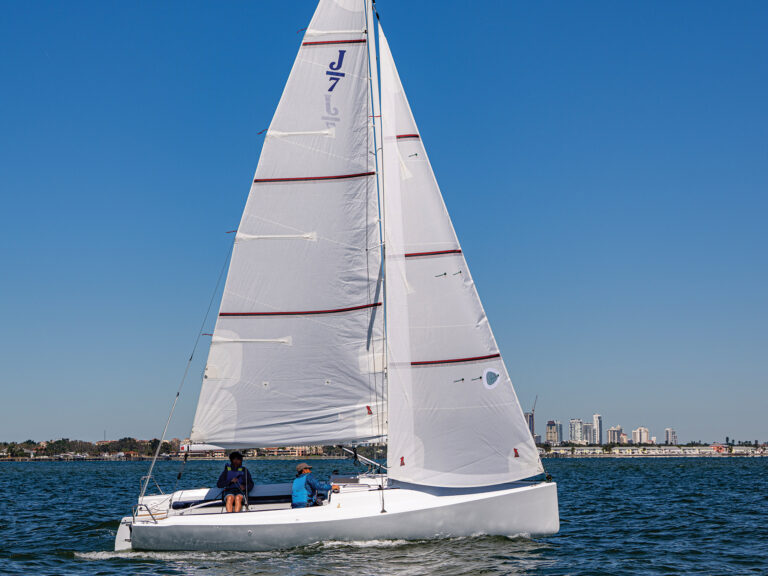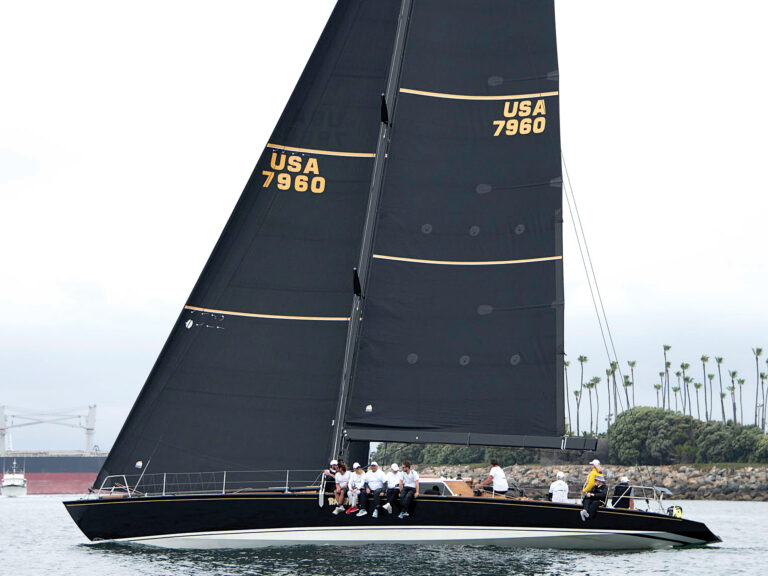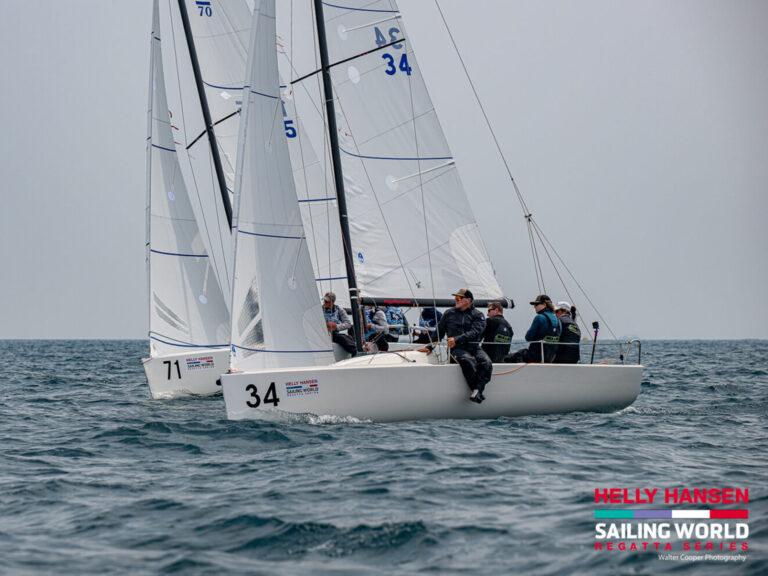The Star Class winter circuit kicked off on Dec. 1 and 2 with the Commodores Cup in Miami. The event was hosted by the Biscayne Bay Star Fleet and Coral Reef YC, and 31 boats, including a number of foreign teams, competed. After three long races a familiar pair of names were at the top of the leader board, Mark Reynolds and Magnus Liljedahl. Though they hadnt sailed together since August, the reigning Olympic gold medalists won the last two races, finished third in the first, and avoided the alphabet soup that sunk a few other strong contenders, including the newly formed British teams of 2000 49er silver medalist Ian Barker and Ed Peel and 2000 Finn gold medalist Iain Percy and Steve Mitchell. To get an idea of what Reynolds plans for the next few years, one doesnt have to look much further than his new website, (http://www.Star2004.com). But we figured wed rather hear it from him. We also wanted to ask him about the recent change in the class weight-limit formula, one which will force many top sailors either to do some serious dieting or to look for lighter sailing partners.
GPS: Mark, congratulations on your win at the Commodores Cup. It looks like there were a few familiar names on the entry list and a few we havent seen much of before?
MR: There are quite a few new people getting into the class, which is really nice. [2000 Star silver medalist] Ian Walkers program looks like it was split down the middle. He had two boats, one is now being sailed by Ian Barker and the other one by Iain Percy. They were both down there for a couple of weeks training and learning the boats. They both looked good. They looked really good.
GPS: What was your motivation for heading east for that particular regatta?
MR: Ive sailed in that regatta quite a bit, but I havent sailed in it every year. The Commodores Cup is the first one that most of the people from out of town start going down to. Weve got a lot of sailing in January and I was pretty anxious to get going, to get back in the Star with Magnus. We hadnt sailed together since the Worlds.
GPS: Is there something specific you missed about sailing the Star with Magnus?
MR: Its just fun. I just enjoy doing it.
GPS: The class recently approved a reduction in the weight-limit formula. Will this be a significant change?
MR: In the past most of the top teams were at maximum weight. At the Worlds, there were a little over 100 boats, and I think 61 of them wouldnt make the new weight limit, and out of the top third of the fleet there were only a couple of boats that would make it, probably only one or two. Almost everybody in the top 20 or 30 had been sailing at max weight
GPS: It seems like it took people here by surprise?
MR: I didnt expect it. Its more of a European thing. You look at the votes, the Europeans voted very much in favor of it, and in the U.S., it was more evenly split. I didnt think it would pass because it would affect so many people. Were fortunate because Magnus is normally a smaller guy than what hes been sailing the Star at. He bulked up a lot to get to that weight. When I first met Magnus, when he was sailing the Finn, he probably weighed 200, 210. And hes a very dedicated athlete. As a matter of fact, he was in favor of the rule, hes one of the guys who was hoping it would pass because hed like to lose a little bit of weight. Some of the other teams will have to adjust.
GPS: So, its not going to affect you too much?
MR: No, it doesnt look like it. And weve got almost five months to get down to weight, so it shouldnt be a problem.
GPS: The proponents of this rule hope it will open up the class to more people. Do you think it will? Is it a good decision for the class?
MR: People were complaining, particularly in Europe, that they don’t have big strong guys. We didn’t want the class to be like basketball where it’s limited to people who are tall enough to compete. We’re the only keelboat class in the Olympics right now so it would be nice to try and accept as wide a range of people as possible. That’s always been the case really for the skipper of a Star boat. In the last Olympics we had guys like Ian Walker who was 165 and Peter Bromby who was 250. There’s not too many places where two guys that different can compete against each other. But there was a problem that Ian had to find a guy who was 280 to crew for him. Now Ian will still have to find a pretty big guy, but a guy like Bromby can take pretty much anybody walking down the street.
It’s been tough because the Star is not just an Olympic class boat. It really has a lot of grassroots support, a lot of fleet sailors. A lot of those fleet sailors went into the boat because they were big guys who couldn’t sail anything else. They couldn’t sail an Etchells because of the weight rule or the 470 or the 49er or classes like that. I’m a little worried that these guys [the Pater Noster Star Fleet in Sweden that proposed the rule] pushed it down a little too far. We’ve got guys who aren’t Olympic athletes, who aren’t as committed as Magnus to losing weight. They’re that size and they’re not going to lose 30 pounds to sail the Star. So it’s a little unfortunate for some of the fleet racers. Although this rule doesn’t apply, for the most part, to fleet activities. It’s really just the worlds and qualifying for the worlds. That actually presents another small problem. Prestigious regattas like the Bacardi Cup, which are not qualifying regattas or a world championships, won’t have a weight limit. Someone can come along with a huge crew and have a little bit of an advantage over us.
GPS: Domestically, there are a lot of rumors flying around about whos going to be sailing the Star during this quadrennium. How do you think things look for the U.S. team?
MR: I think it looks pretty good. The U.S. has a little bit of a problem in that a lot of our good sailors have something else going on, so they cant put quite as much time into it as is necessary for an Olympic campaign. But I know Terry Hutchinsons going to spend most of January sailing the Star boat and Paul Cayards enthusiastic about doing as much sailing as he can. George Szabo just bought a boat. Theres quite a few new people and the worlds are here this year [in Newport Beach, Calif. in August] so thats gotten a few more people to get boats.
GPS: Any one of those sailors that, more than the others, you think could turn it on quickly and become a real threat?
MR: I think all the above. Szabos only sailed off and on, yet he got third at the Trials and won the North Americans. Terry hasnt sailed too much, but hes been right up there in the regattas hes sailed and is only going to get better. Cayard only sailed two regattas last year and I think he got a second and a third in the Springs and Bacardi Cup. Theres also Kevin Hall and Brian Ledbetter. Carl Buchan could be back out there again.
GPS: But its full speed ahead for you for the next few years?
MR: Sure. Weve got a pretty good program planned for this winter and then the boats are coming out west for the worlds in LA. Weve got a new website that I just finished a few weeks ago, www.Star2004.com. Were going to keep adding to that. Its shaping up.
GPS: What about outside of the Star boat. Are you still involved with Philippe Kahns program?
MR: Yeah, I have been. This year I did a ton. We spent quite a bit of time in September, October, and the beginning of November sailing in the Melges 24. A lot of practicing up in Santa Cruz and thats going really well. Weve got a month and half off, and then we meet up in Key West plenty early, where weve got Luther [Carpenter] coaching us. Philippes also sailing the Finn, so he doesnt need any help there, as far as crew is concerned. Hes going to be at the Rolex OCR sailing the Finn dinghy and Im going to be sailing the Star boat. Im going to try to meet up with him on the water so he can hop in the Star and get a feel for that too. He hasnt been in a Star boat before. Maybe thatll be the next boat for him.
GPS: Any bigger boats, longer races?
MR: Im going to do quite a bit of Farr 40 sailing. Its not going to be with Philippe though; hes gotten rid of all his Farr 40s for now. Im going to take Pedros [Peter Islers] place on Revolution for the West Coast series, and I have some other plans in the works for the Worlds. It fits in pretty nicely with the Star.
GPS: By trade, youre a sailmaker. Does this schedule represent a shift for you–the amount of professional sailing youre doing?
MR: This year was a big change. Id done a little bit, Key West every year, a few things here or there. But this year with Philippe, I did a lot with the Farr 40, and then the Melges in the second half of the year. It was fun. Ive got a lot of experience tactics-wise so I can kind of step into those roles. I had a good year. Hopefully I can do more of that this year. And Szabos at the loft and a lot of the stuff I do, talking to customers and stuff, is via email, so I dont always have to be at the loft.
GPS: Its something youre enjoying?
MR: Yeah. I was gone a little bit more than I wouldve liked. Im not gone as much as someone like Terry Hutchinson is or some of those other guys. But still, thats a little disadvantage to the whole thing.
For a complete set of results from the Commodores Cup: http://www.regattabase.com/search.cgi?Action=view&Event;_id=87









